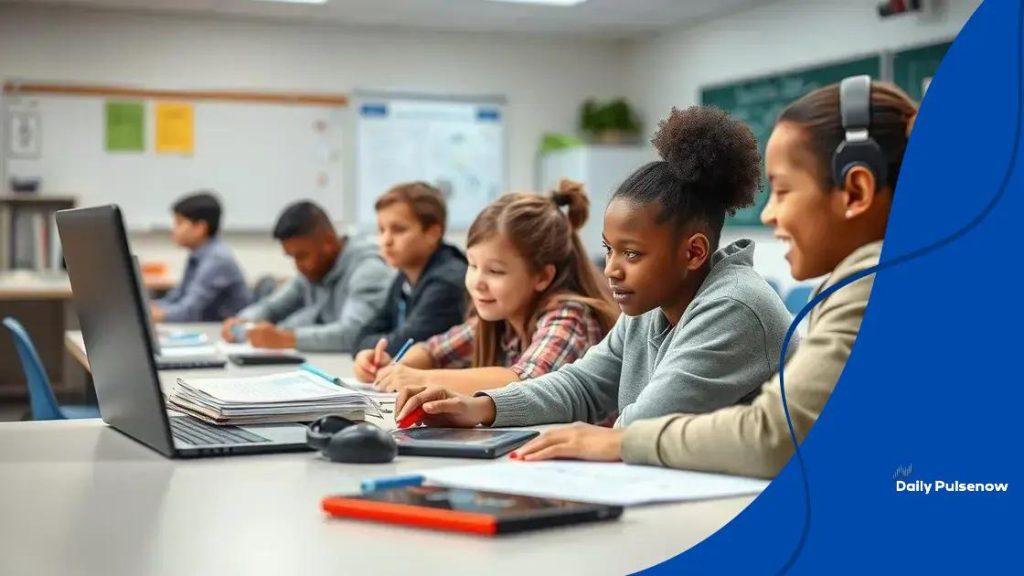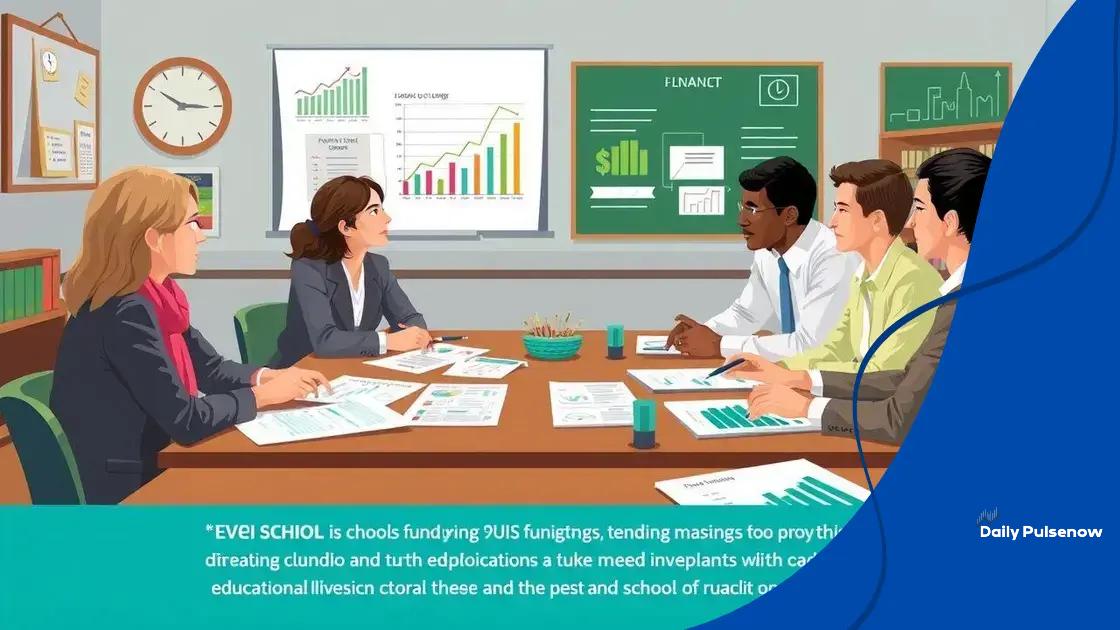Blueprint for Maryland’s Future reforms: What to Expect

Anúncios
The Blueprint for Maryland’s Future reforms aim to improve educational equity, increase funding, enhance teacher support, and ultimately raise the quality of education across the state.
Blueprint for Maryland’s Future reforms represent a pivotal shift in the state’s approach to education, aiming to enhance learning experiences for all students. Have you ever wondered how these changes might affect your local schools and community?
Anúncios
Understanding the Blueprint for Maryland’s Future
Understanding the Blueprint for Maryland’s Future is essential for grasping how education is evolving in the state. This initiative aims to address long-standing issues and improve student success across Maryland.
What is the Blueprint?
The Blueprint for Maryland’s Future is a comprehensive plan designed to transform the state’s education system. By focusing on equity and quality, the Blueprint seeks to provide all students with the opportunities they need to thrive.
Key Components of the Blueprint
- Increased Funding: The Blueprint introduces significant funding increases to support schools and improve resources.
- Teacher Support: New measures to attract and retain qualified teachers include better compensation and professional development opportunities.
- Curriculum Enhancement: A focus on modernizing the curriculum to meet the needs of the 21st-century workforce.
- Wraparound Services: Providing support services that address students’ social and emotional needs.
By prioritizing these components, the state aims to narrow achievement gaps and ensure that every child receives a quality education. The Blueprint acknowledges that education is not just about academics; it also considers the support students need.Maryland is taking bold steps, and discussions around these reforms bring community members, educators, and policymakers together.
Anúncios
In the coming years, we will likely see changes in how schools operate, impacting everything from classroom techniques to the allocation of resources. The hope is that these changes foster an inclusive environment where every student can excel. The excitement around the Blueprint reflects a collective desire for improvement and accountability in education.
Key objectives of the reforms
The Key objectives of the reforms in the Blueprint for Maryland’s Future reflect a commitment to elevating education standards across the state. These objectives are designed to create a more equitable system that meets the needs of every student.
Enhancing Student Achievement
One of the primary goals is to enhance student achievement by ensuring that all students have access to high-quality education. This means implementing rigorous academic standards and aligning resources to support diverse learning needs.
Equity in Education
Equity is at the heart of the Blueprint. By addressing disparities that exist in funding and resources, the reforms aim to create a level playing field for all students, regardless of their background. This involves additional funding for schools in underserved areas and targeted support for students who need it most.
- Improve academic outcomes: Focus on closing achievement gaps among different student groups.
- Focus on early childhood education: Invest in programs that support learning from a young age.
- Expand access to advanced courses: Ensure that all students can participate in advanced placement and honors classes.
- Support for special education: Enhance resources for students with disabilities to ensure their success.
These objectives are foundational for fostering a supportive learning environment. They emphasize the importance of well-rounded education that prepares students not only academically but also socially and emotionally. This holistic approach is key to developing future leaders who are ready to face global challenges.
Furthermore, the reforms aim to increase teacher recruitment and retention by providing better support and professional development. This is crucial, as effective teaching is one of the most significant factors influencing student success. With these objectives, Maryland seeks not only to improve education but to transform the entire educational landscape.
Funding mechanisms and their implications

Understanding the funding mechanisms of the Blueprint for Maryland’s Future is crucial to grasping how the reforms will be implemented and sustained. These mechanisms are designed to ensure that schools receive the necessary financial resources to meet educational goals.
Sources of Funding
The funding for these reforms comes from various sources, including state taxes and grants. This diversified approach not only strengthens the financial base but also ensures that schools can access funds reliably.
Equity Considerations
A significant aim of the funding strategy is to promote equity. Additional funds are allocated to schools serving underprivileged communities. This helps level the playing field for students who may historically have been disadvantaged.
- Increased State Investment: The state will raise its investment in education to meet the demands of the Blueprint.
- Local Funding Contributions: Schools are encouraged to work with local governments to enhance funding sources.
- Grants and Donations: Schools can also seek private grants to fund specific programs that align with the Blueprint’s objectives.
- Performance-Based Funding: Funding can be linked to school performance metrics to promote accountability.
The implications of these funding mechanisms are far-reaching. With more resources, schools can implement programs that focus on student achievement and teacher support. This means investing in better teaching materials, modern technology, and staff development.
Moreover, reliable funding allows for the expansion of essential services like counseling and after-school tutoring. These services are vital for students who may need additional support to succeed. As funding is secured, educators feel more empowered to innovate their teaching methods without the constant worry about resource limitations.
Expected impacts on education quality
Analyzing the expected impacts on education quality due to the Blueprint for Maryland’s Future reveals a comprehensive shift that aims to improve student outcomes significantly. With dedicated efforts to reform various aspects of education, the quality of teaching and learning can be enhanced across the state.
Improved Academic Performance
One immediate expectation is improved academic performance among students. By implementing higher standards and providing better resources, educators can facilitate a more effective learning environment for all.
Engagement and Support
The reforms focus on increasing student engagement through innovative teaching methods and support systems. For instance, enhanced training for teachers will empower them to adopt more interactive and participatory classroom strategies. This approach can spark curiosity and motivate students to participate actively in their learning.
- Higher graduation rates: With more resources, students are likely to stay in school and complete their education.
- Reduced achievement gaps: Targeted support for disadvantaged students can help bridge gaps in learning.
- Increased access to technology: Expanding access to digital tools will prepare students for a tech-driven world.
- Enhanced critical thinking skills: By emphasizing problem-solving and analysis, students will be better prepared for real-world challenges.
As schools adopt these reforms, they will likely see a transformation in the classroom environment. Teachers will have the tools necessary to implement personalized learning plans catered to individual student needs. This customization can address diverse learning styles, leading to better retention of information.
Moreover, with increased emphasis on mental health and well-being, schools will implement more comprehensive support systems. Students will not only gain academic skills but also develop essential life skills, including resilience and collaboration. These changes suggest a future where education quality is not just an aspiration but a reality for every learner in Maryland.
Challenges and considerations for implementation
The challenges and considerations for implementation of the Blueprint for Maryland’s Future highlight various hurdles that must be navigated to achieve successful educational reform. While the goals are ambitious, understanding potential obstacles is crucial for effective implementation.
Funding Limitations
One significant challenge is securing adequate funding. The reforms require substantial investments to ensure that all schools can access necessary resources. Without stable funding, schools may struggle to meet the promised improvements.
Infrastructure Issues
Many schools may face infrastructure problems that could hinder the successful rollout of new programs. Aging facilities may need upgrades, and technology updates will be essential to keep pace with modern educational demands.
- Staffing Challenges: Recruiting and retaining qualified teachers is vital, yet many districts face shortages that may impact student learning.
- Resistance to Change: Some educators and community members may resist new approaches, making buy-in essential for a smooth transition.
- Balancing Diverse Needs: Addressing the diverse needs of students requires careful planning and tailored strategies, which can be complex to implement.
- Monitoring and Assessment: Developing effective evaluation methods to measure the success of reforms is necessary for accountability.
These challenges underscore the importance of strategic planning and community involvement. Engaging stakeholders, such as parents and local organizations, will be key to overcoming resistance and fostering a supportive environment for these reforms. Additionally, clear communication about the objectives and benefits of the Blueprint will help build trust and commitment within communities.
Effective training for teachers and staff will also be essential. Providing the necessary professional development will enable educators to adapt to new curricula and instructional strategies, ensuring they feel confident in their abilities to implement changes effectively.
FAQ – Frequently Asked Questions about Maryland’s Blueprint for the Future
What are the main goals of the Blueprint for Maryland’s Future?
The main goals include improving educational equity, increasing funding for schools, enhancing teacher support, and raising overall education quality.
How will funding be allocated under the Blueprint?
Funding will be allocated from state taxes and grants, focusing on schools in underserved areas to ensure all students receive quality education.
What challenges might schools face when implementing the Blueprint?
Challenges may include securing adequate funding, addressing infrastructure issues, resistance to change, and ensuring community involvement.
How can communities support the implementation of the Blueprint?
Communities can support by engaging with schools, advocating for resources, and participating in discussions about educational changes.